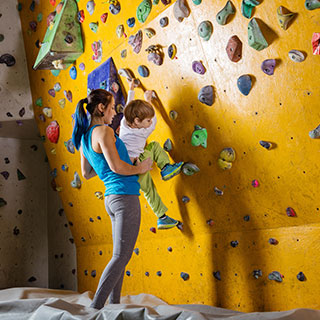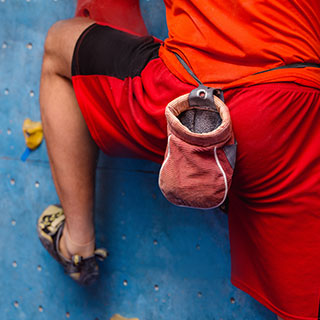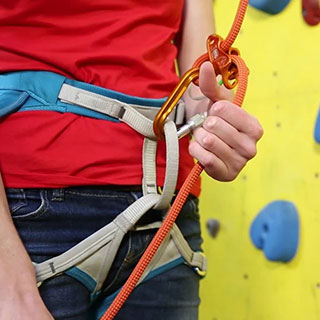You’ll find people who advocate for how great indoor climbing is, but you’ll also find those that insist outdoors is best. One of the great perks of climbing inside is that you are protected from the weather and can really work on, and focus on areas you want to improve, without being thrown off by the elements!
In this guide and through our reviews, we’ll cover everything you need to know about indoor rock climbing. From basic instructions to how to build your own wall and the equipment you’ll want to have, read on to find everything you need to become an indoor rock climbing expert!
AT A GLANCE
Basic Instruction for Indoor Rock Climbing

Indoor rock climbing is fast becoming a really popular form of climbing, particularly as the first indoor climbing gym was only opening in 1987. Climbing indoors is a really great way to learn because the whole environment is much more controlled than climbing outside. It’s a safe way to learn all the basics, and a convenient way to practice. Unlike climbing outside, indoor centers never get too dark, cold or rainy.
In this basic instruction section, we’ll take you through climbing techniques, good habits, how to build balance, control and power, as well as how to develop your skills and tactics.
Learn Climbing Techniques from Basic to Advanced
In most indoor rock climbing centers, you can learn through courses that go from a basic to advanced level. With basics, you’ll focus on safety and know about your equipment. You’ll learn the basics of how to climb. At a mid-level course, you’ll cover techniques which focus on using the auto locking belay device, and various new climbing techniques. Finally, through advanced courses, you’ll learn how to climb and belay really safely,
Establish Good Climbing Habits
When learning anything for the first time, they is to not get into any bad habits. That’s why being trained by a professional is really important, as they can help you establish the very best climbing habits. They will help you develop the right belaying technique, clipping, anchoring to the floor, falling, rope management, spotting and how to get the right body position. Some of the bad habits you might hear about include scuffing your feet, being
Develop Balance, Control and Power
Three things you must have to climb really well is balance, control and power. Now, these three things can be developed over time, you don’t need to have them to begin, but they are three words that are really important to remember. If you have great balance, then you will climb smarter, better, more efficiently, avoiding falls. It’s important to find your center of balance, use your entire body when climbing, and to really try and avoid staying
Develop Your Skills and Tactics
There are many skills and tactics to master with indoor climbing. Firstly, don’t think you will get them all overnight. This sport is gradually learned over time, and with a lot of practice. And we really mean a lot of practice. Rock climbing indoor requires real commitment if you want to develop your skills. To help you improve your tactics and skills you can make sure you stretch a lot. It will help you be more flexible, which in turn will
How to Build an Indoor Climbing Wall?

These days indoor rock climbing walls are made out of plywood, over a metal frame, so that lots of different routes can be created. They are often sprayed with a texture and color similar to a real rock face so as to make indoor climbing as much like outdoor as possible. So how can you build your very own indoor climbing wall?
Planning & Brainstorming
When you’re planning to build your own indoor climbing wall, you need to think about what you want. What are your objectives? Why do you even want to build a wall? Asking yourself these types of questions will help you brainstorm ideas and develop a plan.
Once you know what you want to achieve, you will be able to think about the shape, features and size of the wall you
Calculate Your Space
If you want to build a good indoor climbing wall, you need to have the space to do it. You don’t want a scenario where you start building your model and suddenly realize you’ve run out of space! The best place to start is by looking in detail at the space you have and thinking about how to use it most efficiently. If you live in a small home, think about what else is going on around the wall and if you need to use for anything else. One thing
Designing
When designing your indoor rock climbing wall, you’ll need to mock it up as a small scale model, and then actually in the location you want to build. You can use tape or a removable marker to show exactly where everything will be positioned. This will help you to visualize and imagine what the wall will look like and how the elements will work together. When designing, try to keep it as simple as possible. Adding too many complex
Gathering Tools & Materials
To build your climbing wall you will need to have the right tools to do the job correctly. These will need to include a drill and drill bits, a jigsaw, a measuring tape, a speed square, a hammer, a chalk line, a bolt, pencils, a chisel, extension cords, safety glasses, a step ladder and a wrench. These cover the most common tools, you made need some more specific items, but these are
Construction
Here we are going to take you through the process of constructing your indoor rock climbing wall. This scenario is the most common, the situation you are in may vary, but what will talk you through should apply to most scenarios.
Here we are going to take you through the process of constructing your indoor rock climbing wall. This scenario is the most
Holds
Choosing the right climbing holds is one of the most important things to do when building your own indoor rock climbing wall. They are likely to be very expensive, so you will want to make sure you think carefully about your decision and how to spend your money wisely. Even though holds are expensive, you’ll still want to invest in enough holds and also a good mix, because this is what makes indoor climbing interesting. Be careful not to
Course Setting
The course you design for your wall will be the most fun if you think about it in some detail. Try to think about lots of different moves and don’t always use big footholds. The course you set should match back to the goals you want to achieve. Once you’ve come up with a really good course, make sure you mark it with tape, so that you can do it again!
Addressing Safety Considerations & Maintenance
Keeping your wall safe is really important and should be your number one priority. Regularly check your holds and remove them if they are cracked, or tighten them if they are loose. Also check the T-nuts often, as they may become stripped or cross threaded. First try and tighten or loosen it, or pry it out using a pry bar. Finally, make sure you check all the other areas of your wall every now and again, as you may need to repair different
Indoor Climbing Equipment

Climbing indoors with the right kit is really important. If you’re using the wrong gear you could become really uncomfortable, and even be unsafe. Quite often you can hire kit from the gym you are learning at. If you’re building your own wall and are completely hooked on climbing, then this is the kit you will need. Generally, you’ll need the same equipment for men and women.
For rock climbing indoor, you need specific shoes. They have lots of different features that we can explain in more detail. Most indoor rock climbing shoes have flexible and grip-able soles, making them great for climbing. Firstly, they are made of rubber, which makes it easy to grip. When choosing your shoe, make sure it fits tightly, and look for a shoe with padding
Firstly, always use a chalk ball and never loose chalk. This is because chalk balls will reduce the amount of dust you leave in your wake. They are made of a fabric with the loose chalk kept inside the ball, some are even refillable. The chalk will help you battle excess moisture and improve your grip on the wall, as well as being cheap. The only downside with a chalk ball is
iiiChalk bag
The most important thing about your chalk bag is having one big enough to get your hand into! Apart from that, there are loads of different chalk bags available, all which are quite cheap. Essentially they just strap around you and hang down your back. In terms of tightness, they need to be really secure, so that it isn’t hanging low on your back, dangling uncomfortably,
Every harness has to be of a certain safety standard, but you will be able to find various brands that fit differently. Again, it is important to try the different varieties to see which is most comfortable. You can buy harnesses with adjustable and non-adjustable leg loops. Harnesses with no adjustment are lighter and slimmer in their look, whereas adjustable leg loops
A belay is there to act as your brake when climbing, so it is really important. It’s a safety piece of equipment that keeps you secure by applying friction. We recommend that you choose a belay with grooves, as this will minimize the amount of friction you feel. Belaying is a really important climbing skill that you
When shopping around for a carabiner you need to think about its shape, gate type, size, weight, and strength. The most commonly used carabiner is that with an asymmetric D shape. They have a small end to decrease weight, and a larger opening to make it easy to fix them on and off. As they are the most popular variety, they are often quite expensive. The
For kids, you will want them to have a full body harness and helmet. They are very similar to an adult’s harness but are designed to fit a child. Full-body harnesses are for children under 5, as they shouldn’t be used on a child that weighs more than 40kg. Young children need this kind of full body harness because they have a higher center of gravity compared to us
viiiHelmet
Like other pieces of your indoor rock climbing equipment, the helmet is ultimately there to protect you. Again, like other items they need to meet a certain safety standard, so always check this before buying. For indoor climbing, you need the helmet with the least amount of protection, as you are unlikely to hit real rocks! You can choose quite a light, cool foam helmet,
When you become a really experienced climber and are leading routes, you will need to take your own rope with you to a climbing center. At first, when you are a beginner, most walls will have their own ropes for top-roping that you can use. When looking to buy a rope, there a few things you need to look for. Often it depends on the type of climbing you are
Crash pads are really important for keeping you safe and healthy when climbing indoors, and outdoors up a tree! You need to look for a pad that will provide you the protection you need if you were to fall, so it should have a few layers of foam. They are usually not too heavy, coming in at 5-10kg, but we would still recommend looking for one with straps and buckles
Risk Factors of Indoor Climbing

With all the safety equipment you need for climbing indoors, there are 100% risks to taking on this sport. Often people don’t have a go, because they are scared of falling and hurting themselves, which is normal. Indeed, getting roped up and climbing some 50-plus feet from the ground or going support-free on boulders does seem like a dangerous undertaking. To reassure you, we looked at some of the research on the issue to determine how risky the sport actually is:
The chance of getting an acute injury whilst climbing indoors is actually quite small a risk, and unlikely. On the small chance that injuries did occur, most commonly they were amongst men and were when they were lead climbing or top roping. Often these injuries happened, because of poor belaying skill and bad falling patterns. It really shows how important it is to spend time learning the right technique. Although some injuries do occur, they do with any sport. Based on the research, indoor rock climbing has been classified as a low-risk sport, so your worries can now be at rest!
Some factors which do put you at a higher risk of injury include if you have been climbing for a long time, generally more than ten years, and if you are experienced and climbing really hard routes. You may be particularly worried about letting your child climb, which is understandable. The frequency of injury, like adults, is low but if children do get injured, it tends to be low risk injuries like sprains or strains.
How to Minimize Risks

So there are some risks to rock climbing indoor, albeit they are relatively low. However, when any risk is present, it is always good to know how to minimize this risk. Firstly, knowing what risks may face you is really important. If you understand what might happen, then you can learn how to be safe.
As well as knowing the risks, you also need to know your ability level. You might not be able to climb for as long, as far, or on as hard routes as your friend. As soon as you push yourself too far, you are at risk of injury. Indoor rock climbing is all about building up your level and time on the wall, it is not about competing. Remember, take breaks and stop if you feel a pain.
Taking time to learn skill and technique is really important. If you think about your technique and focus on it, that will help you reduce your risk of injury. Always remember that safety must be your number one priority. If you pay attention to all the checks and don’t cut corners to be quicker, then you will keep your risk of injury low.
Keeping fit and active is really important. As well as eating well, we need to get up and about, and sport is a great way to do this. Rock climbing indoor is a more obscure and sometimes a sport that people are fearful of, but we have hopefully shown you how climbing can be safe and fun!
In this guide for beginners and through our reviews, we’ve given you all you need to know about indoor rock climbing. You should now feel confident on the basics, on how to build your own wall, and the equipment you’ll need to have. Now, all that is left to do is find your local climbing center or get building your very own wall at home!



























































